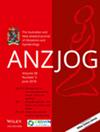在疑似胎儿生长受限的情况下,sFlt-1/PlGF和PlGF可能在早产和出生体重< 3百分位的风险分层中有价值:一项盲法队列研究。
IF 1.7
4区 医学
Q3 OBSTETRICS & GYNECOLOGY
Australian & New Zealand Journal of Obstetrics & Gynaecology
Pub Date : 2025-02-12
DOI:10.1111/ajo.70003
引用次数: 0
摘要
我们研究了在招募时没有先兆子痫迹象的疑似胎儿生长受限(sFGR)患者中测量sFlt-1/PlGF的价值。当sFlt-1/PlGF bbb38或PlGF时,血管生成生物标志物被认为是阳性的本文章由计算机程序翻译,如有差异,请以英文原文为准。
In Suspected Fetal Growth Restriction, sFlt-1/PlGF and PlGF May Have Value in Risk Stratification for Preterm Birth and Birthweight < 3rd Centile: A Blinded Cohort Study.
We investigated the value of measuring sFlt-1/PlGF in people with suspected fetal growth restriction (sFGR) without signs of preeclampsia at recruitment. Angiogenic biomarkers were considered positive when sFlt-1/PlGF > 38 or PlGF < 100 pg/mL. Clinicians were blinded to the sFlt-1/PlGF results. In sFGR presenting < 32 weeks, but not ≥ 32-37 weeks, positive angiogenic biomarkers vs. NZ FGR criteria had increased risk of preterm birth RR 5.32 [2.04-13.88] vs. 2.19 [0.89-5.37], respectively, and birthweight < 3rd centile RR 2.11 [1.24-3.58] vs. 1.83 [0.92-3.63], respectively. Larger studies are needed to establish whether routine testing of angiogenic biomarkers in sFGR is recommended for risk stratification.
求助全文
通过发布文献求助,成功后即可免费获取论文全文。
去求助
来源期刊
CiteScore
3.40
自引率
11.80%
发文量
165
审稿时长
4-8 weeks
期刊介绍:
The Australian and New Zealand Journal of Obstetrics and Gynaecology (ANZJOG) is an editorially independent publication owned by the Royal Australian and New Zealand College of Obstetricians and Gynaecologists (RANZCOG) and the RANZCOG Research foundation. ANZJOG aims to provide a medium for the publication of original contributions to clinical practice and/or research in all fields of obstetrics and gynaecology and related disciplines. Articles are peer reviewed by clinicians or researchers expert in the field of the submitted work. From time to time the journal will also publish printed abstracts from the RANZCOG Annual Scientific Meeting and meetings of relevant special interest groups, where the accepted abstracts have undergone the journals peer review acceptance process.

 求助内容:
求助内容: 应助结果提醒方式:
应助结果提醒方式:


